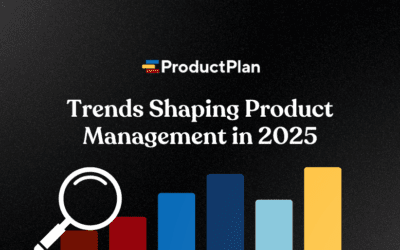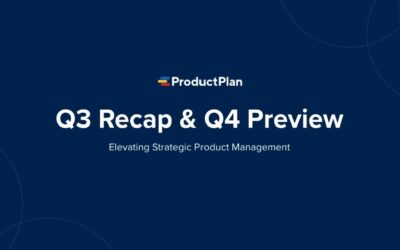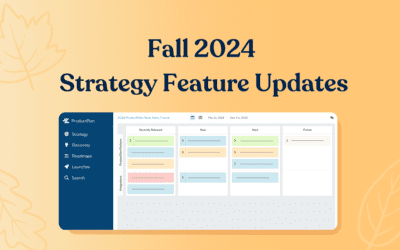A 2020 study conducted by Clutch surveyed over 500 businesses. Only 5% of companies identified that they accomplished all their goals in the past fiscal year. Moreover, the survey results established that 65% of those businesses completed at least half of their goals. Clutch’s survey proves that you need an effective product management strategy to measure product vision success.
As a product leader, your product vision anchors everything you communicate to your team. The concept provides your organization with the ideal product.
First, you must realize you need to test your product vision before developing a product strategy. Much like the agile process, your picture gets better as you build, measure, and learn. As such, your product vision becomes the product narrative you, as a leader, tells.
While looking back at your vision, you’ll need to make sure your team remains proactive. Remember, your product vision may be an idea or an aspiration. To help your product team get there, you’ll need to learn from your actions.
You’ll need to put your head down to gather information and then sell the rest of the company on your vision. Your product vision reflects the big picture and helps you, your team, and your peers make long-term decisions. Your informed decision-making drives your culture and moves the business forward.
The vision may remain stagnant, though. Even after you write it, the product strategy needs to evolve. Adjustments lead to significant improvements.
The end of the fiscal year can provide your team with the time to adjust. Let’s talk about answering the question:
How did I do last year?
Product Vision Exists In The Work You’ve Done.
Metrics are crucial. When it comes to vision, you can’t count clicks.
That is where proxy metrics come in. Proxy metrics are variables that can help you understand something unobservable. So when it comes to vision or leadership, having great proxy metrics is essential.
Proxy metrics help you gain visibility into how you operationalize that vision. That’s where goal frameworks come into play.
Proxy metrics, even far removed from the leadership level, can give insight. Let’s take a goal framework and go a little deeper into what they can tell you, even if it’s four levels down.
Objective and Key Results (OKRs) are popular these days. When they work well, they function as an excellent proxy metric. Why? They can help a leader see how aligned the team is via something as simple as a spreadsheet.
A good question to ask here is, are the objectives you see aligned to that ideal vision?
If those objectives aren’t, there is no better time to think back to what caused the misalignment to the vision.
Did something change?
Are teams getting the correct information?
Do teams feel safe enough to ask questions?
All good things to think about as you judge how close you are to those product ideals: now, how about a particular measurement to keep alignment?
Tracking A North Star Metric Helps Tie Movement To Vision
Another tool to help set alignment is a north star metric. As John Cutler mentions on the blog, an effective north star metric keeps alignment. It’s important to remember the key characteristics of an influential North Star:
- North star helps focus on customer value and the exchange of value. For example, daily active users (DAUs) don’t tell you anything about the value exchanged.
- The metric represents your unique product strategy.
- Moreover, it connects the customer value you are trying to create as a product team. The executive team cares about this connection the most.
As a north star becomes real, this is a great time to look at the initiatives to see if they moved your north star by looking at the significant projects shipped to see how they affected your north star.
- Did you see spikes in your proxy metrics or North Star?
- How about any dips?
- Did you make any bets in your product strategy that would affect the North Star? How did those bets pan out?
Remember, things don’t always go to plan. The releases that happened during the year may have had an adverse effect. Ignore this at your peril.
Failures Are Essential, Too
Success is helpful for team morale. That said, analyzed failure is more beneficial for team growth.
Let’s be clear. Failure on its own isn’t helpful. Don’t fall into the trap of lionizing failure for the sake of loss. Spend time analyzing the failure so that teams can understand how to make better choices in the future and learn how to prioritize their time better around the demands of product planning.
Why? Product development doesn’t always go to plan. In fact, as a product leader, if things always went how you planned, you aren’t paid enough. Sometimes, taking a risk, or force de jour, bad things happen.
The bad news is failure doesn’t feel good. The good news is once you’ve had some time to recover, there are lessons in failure. Those lessons can help you and your team get even better the following year.
Embrace Your Product Failures
Write them down. Do not hide those failures. Failures come in different forms.
A quick note: it’s easy to point out the vast failures. The ones that create ripples in the organization are substantial to note. They are drama-filled, and your strategy may change forever. Make sure, though, that you capture the less noisy failures. These look different but can be as deadly long-term.
You need to judge features by the return on investment as much as the noise they create.
The project went “according to plan” yet didn’t make a splash in the marketplace. It’s a slack integration that didn’t move the north star. You invested in a product team for a quarter, and nothing changed.
These failures are silent at the moment but cost the company millions. But when you catch them, offer a great chance to look at the process.
The failure is an opportunity to look at your process:
- Was our discovery process unclear?
- Was this a me-too feature – something we saw our competitors do and copied?
- Why was this prioritized?
Things don’t always go to plan. Your team will go through trials, and those trials are unavoidable. What separates the product visions that evolve from those that wither? Product teams use what they go through as fuel. As you judge the year, it’s a great time to look at those failures and see what you can learn.
Download the Product Roadmap Kit ➜
Facing the Consequences of Your Product Vision Decision
Your failures, and successes, for that matter, don’t exist in a bubble. The company that supports your product vision is an organism. The organism adjusts to what happens.
After an event happens, something happens afterward. That “something” is a “second-order effect.”
Second-Order Effect refers to the idea that every action has a consequence. Then, each result has a result.
In other words, a single decision can start a series of cause-and-effect. The results can lead to shifts in culture.
There are bound to be shocking things, some of which felt “out of nowhere.” That is likely the second-order effect of an outcome.
Write those surprises, and like you did with team failures, investigate them.
Let’s take that Slack integration we talked about earlier. The feature had a specific purpose. But, the lack of impact could have had some downstream effects.
Was there a particular decision that led to a shift in something unrelated?
Did our communication patterns change?
Were there any culture changes that caught us by surprise?
Writing down what took the team by surprise can help you draw a map of those second-order effects. If you create clarity there, you can use them to fuel your growth into next year.
How to Utilize Customer Segmentation
You’ll find that the issues you have will not apply to everyone. When taking a look back at the year, it’s a tremendous opportunity to ask yourself the question:
- Do we care about these people?
It doesn’t seem warm-hearted, but our vision can’t do everything for everyone. When teams spend time on customers that don’t fit with the business, they waste time.
When you build for someone you don’t intend to serve, you are stealing from valuable customers. Stealing time may seem harsh, but that is an outcome of a lack of focus.
So, who are your most important customers? Now is the time to take the time to talk to your team and look at the data:
- What customers drive revenue?
- Who are the customers that drive stickiness on the platform?
- Of those customers, how happy are they?
Net Promoter Scores (NPS) are helpful here. NPS is a survey question that asks how likely you are to recommend this product on a scale of one to ten. The number has limited use, but it can signal the health of a segment in the total.
NPS is powerful when you segment your users.
If you segment your users, you have a great way to understand who likes your product and those who don’t. The promoters (9-10), like it, represent an opportunity to get case studies. The detractors (0-6) are the canary for potential issues.
They present themselves as opportunities to learn. Understanding what drives those users to that score will help strengthen the vision. There is also an opportunity to see what is impactful, especially as you get scores over time and see where the most significant shifts happen.
Themes and Trends for the Product Vision
When looking at all the data and segments, you are looking for themes. Vision isn’t about one change or another that works for lower-level strategy. You are looking to impact as large of a swath of your business as possible.
When you digest the data, you’ll want to take a step back. Let the data dance in your head for a while, and you’ll notice a few prominent themes.
Something else should come with those themes. The business isn’t stagnant, so the data you see will be moving. These are the shifts we mentioned earlier.
Combining both will give you something to communicate to the rest of the business. Themes are great to take back to the c-suite; it’s at a level you can discuss without getting too much into the weeds. It will color the business for them. The trends will give them the numbers to help you and the rest of the company to act.
If this sounds familiar, it should. Themes and trends are qual and quant working together. You need to sell the vision. Have solid and explicit themes and trends will help you do that.
As you take a look at the themes and trends, you’ll want to know the following:
- Are these themes impactful?
- Will they cover a material part of the business?
- Are the trends clear?
- Are they tied to metrics that are proxy metrics to the health of the company?
- Do the themes and trends match?
- We need to tell a story.
Looking at the changes for the year isn’t enough. You’ll need to tell a cohesive story to the product team and the rest of the business to sell your vision again.
Measure Product Vision with Your Product Roadmap
Product isn’t linear, and neither is our vision.
Your vision mustn’t become stale – business moves fast. As a product leader, you’ll need to ensure that you don’t make the mistake of assuming the vision is evident.
Taking the time to go over the last year is essential. You need to check in on the changes, north star, failures, and segments. It would be best to sell what you see to the rest of the business with themes and trends.
The end of the year provides an excellent time to reevaluate what your team has accomplished.
Your roadmap, driven by ProductPlan, is a great way to tell the story. That is why it is best to support that roadmap with a vision to drive organizational change.
Remember, your vision is a tool to help people understand. Take the data from this research to find the connective tissue past the features and tell the story.
Your vision is the big picture, and taking time to reflect on reinforcing your product story is valuable. As a leader, it’s a skill that will be useful throughout your career.
So take advantage and set yourself up for looking forward over time. Get up and see the potential around the corner.
Discover what ProductPlan has to offer. Then let your vision lead the way.



